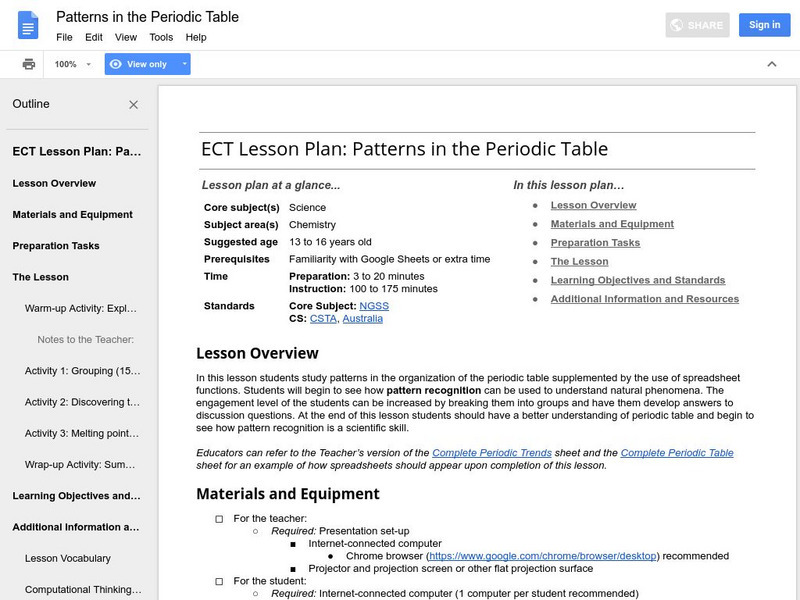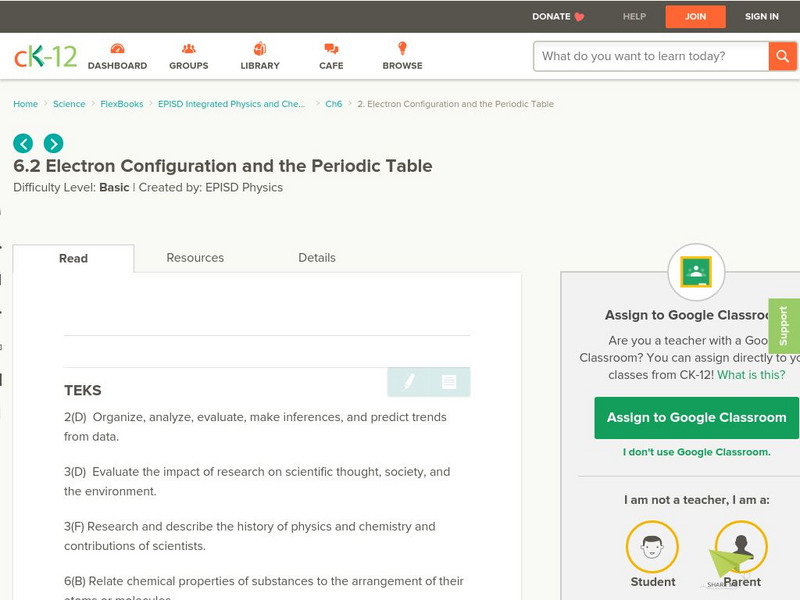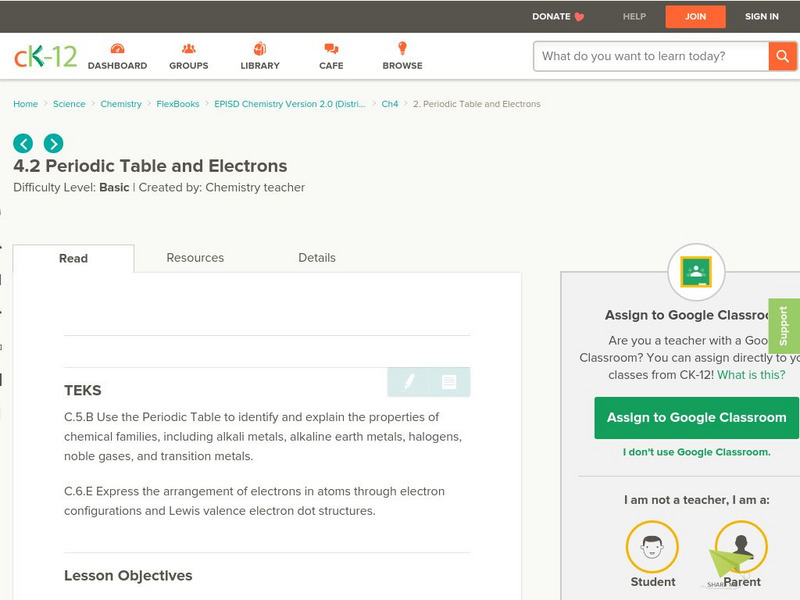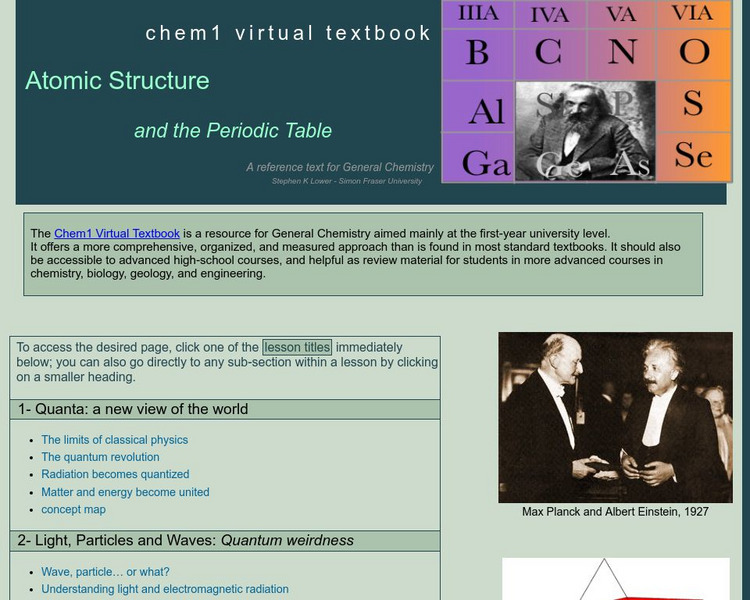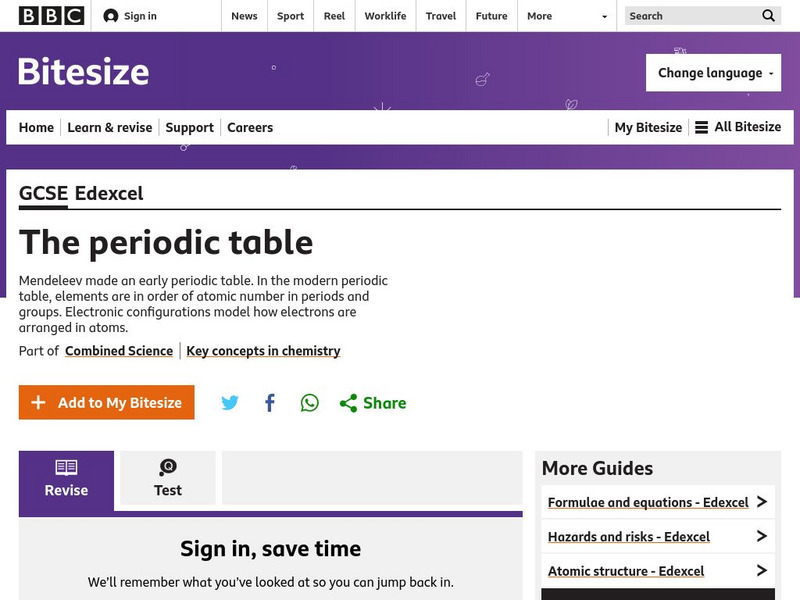Hi, what do you want to do?
Curated OER
Covalent Bonds
After a short introduction, chemistry aces get right into drawing electron dot diagrams for covalent bonds. There are only three questions to answer, so this is not a comprehensive worksheet. It can be used when introducing your class to...
Google
Google for Education: Patterns in the Periodic Table
Students study trends in the periodic table of elements, supplemented by the use of spreadsheet functions. The spreadsheet functions presented can be used on any data set.
CK-12 Foundation
Ck 12: Trends in the Periodic Table
[Free Registration/Login may be required to access all resource tools.] Students investigate specific properties that can be predicted by an element's position on the periodic table. Additionally, they will look at the formation of ions,...
Google
Google for Education: Example: Patterns in the Periodic Table
A lesson plan where students examine the trends in the periodic table.
Texas Education Agency
Texas Gateway: The Arrangement of Elements: The Periodic Table
In this tutorial, students will investigate the arrangement of the Periodic Table by watching videos, completing interactive activities, and quizzes.
Science Struck
Science Struck: Metalloids in the Periodic Table
Discusses the history and organization of the periodic table, where the metalloids fit in, and their properties. Includes color-coded periodic table of elements.
TeachEngineering
Teach Engineering: Engineering and the Periodic Table
Students learn about the periodic table and how pervasive the elements are in our daily lives. After reviewing the table organization and facts about the first 20 elements, they play an element identification game. They also learn that...
Science Education Resource Center at Carleton College
Serc: Valence Electrons and Trends in the Periodic Table
This instructor led activity will produce a partially filled periodic table that contains electron-dot models for the first twenty elements in the appropriate boxes. It will be used as a visual tool for students to connect concepts such...
CK-12 Foundation
Ck 12: History of the Periodic Table
[Free Registration/Login may be required to access all resource tools.] In this online tutorial students will begin to explain the use of chemical and physical properties in the historical development of the Periodic Table. They will be...
CK-12 Foundation
Ck 12: Electron Configuration and the Periodic Table
[Free Registration/Login may be required to access all resource tools.] In this learning module, students will explore how the form of the periodic table is related to electron configurations, which in turn influences chemical reactivity.
CK-12 Foundation
Ck 12: Electron Configuration and the Periodic Table
[Free Registration/Login may be required to access all resource tools.] In the following online tutorial students will sse the Periodic Table to identify and explain the properties of chemical families, including alkali metals, alkaline...
Khan Academy
Khan Academy: The Periodic Table, Electron Shells, and Orbitals
The Bohr model and atomic orbitals. Using an element's position in the periodic table to predict its properties, electron configuration, and reactivity.
BBC
Bbc: Gcse Bitesize: The Periodic Table
Elements in the same group in the periodic table have similar chemical properties. This is because their atoms have the same number of electrons in the highest occupied energy level. Group 1 elements are reactive metals called the alkali...
BBC
Bbc: Gcse Bitesize: What Does the Periodic Table Tell Us About the Elements?
The number of protons in the atom of an element determines its place in the Periodic Table. The number of electrons in an atom is the same as the number of protons. These electrons are arranged in shells or 'energy levels' around the...
Utah Education Network
Uen: The Periodic Table and the Universe
Students will apply the atomic number of elements on the periodic table to the origin of heavy elements in the star cycle.
Simon Fraser University
Chem1 Virtual Textbook: Atoms and the Periodic Table
As part of the General Chemistry Virtual Textbook, this site examines a list of related topics (in hyperlink format) on the atom and the Periodic Table of elements. Topics from light, particles, and waves to the Bohr model, quantum...
Texas Instruments
Texas Instruments: Getting Started With the Periodic Table App
In this activity, explore the periodicity of the periodic table with the Periodic Table App.
American Chemical Society
Middle School Chemistry: Periodic Table and Energy Level Models
Students interpret the information given in the periodic table to describe the arrangement of electrons on the energy levels around an atom.
Annenberg Foundation
Annenberg Learner: Interactives: Periodic Table
Learn the basics of the Periodic Table including how the Periodic Table is organized and how to make sense of the information included in the table. Test your understanding with an interactive quiz at the end of the activity.
Sophia Learning
Sophia: Periodic Table: Lesson 4
Explain how elements on the periodic table are arranged, and explain the relationships within each row and column. This lesson is 4 of 4 in the series titled "Periodic Table."
BBC
Bbc: Gcse Bitesize: The Periodic Table
This lesson focuses on the periodic table and the configurations. In the modern periodic table, elements are in order of atomic number in periods and groups. Electronic configurations model how electrons are arranged in atoms. A link to...
BBC
Bbc: Gcse Bitesize: What Does the Periodic Table Tell Us About the Elements?
The elements in Group 7 of the Periodic Table are called the halogens. They include chlorine, bromine and iodine. Learn about their properties and uses, then take a quiz.
Texas Education Agency
Texas Gateway: Matter and Energy: Periodic Table
Learn all about the periodic table in this interactive tutorial.
CK-12 Foundation
Ck 12: Plix: Mass Number: Writing the Periodic Table
[Free Registration/Login Required] Put the elements in the correct order on the table by using the information given in each of the element squares.






